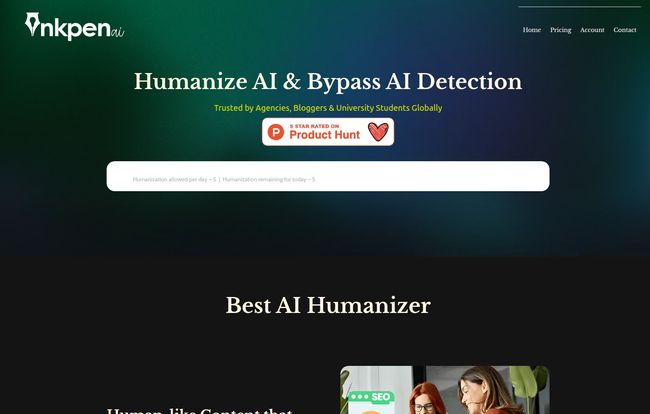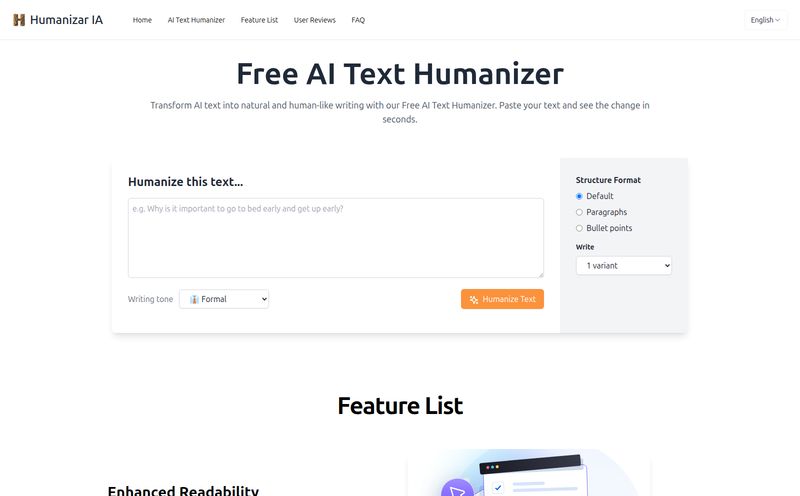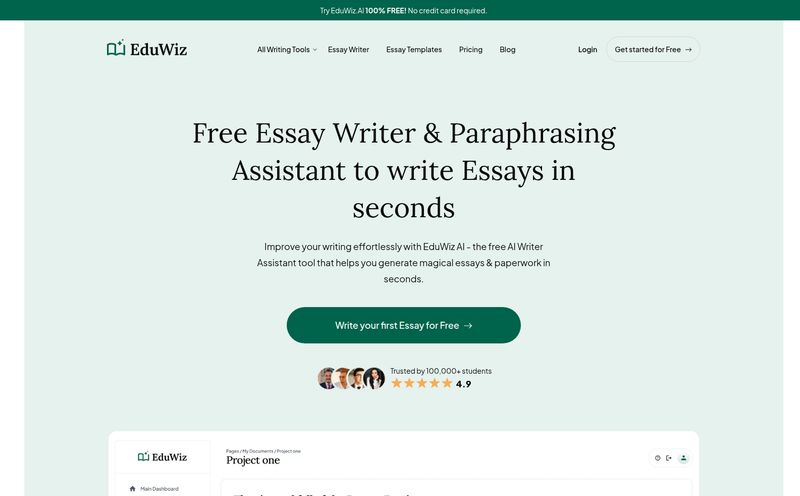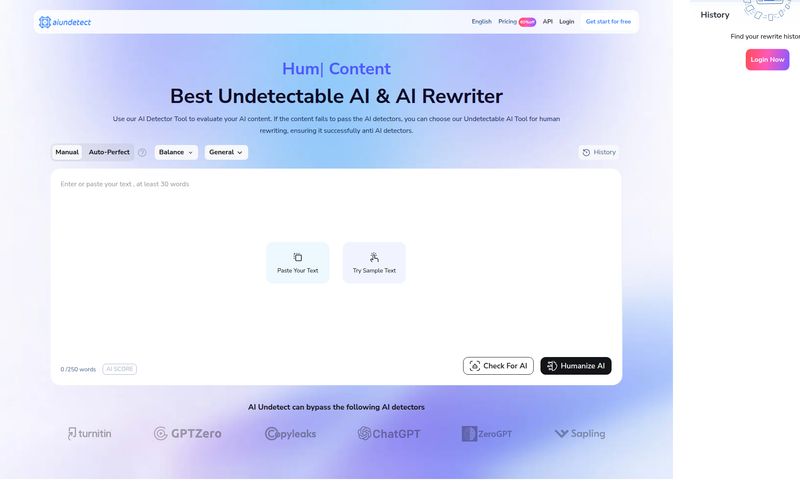You, me, and the giant AI elephant in the room. For the past couple of years, we've all been on this wild ride. First, AI content was the secret weapon. Then, it became the cheap shortcut. Now? Now we're all terrified our sites will get slapped by Google for sounding like a robot wrote our last 50 blog posts. We've all seen it – that perfectly structured, soulless text that screams, "I was generated by a large language model."
It's a problem. A big one. Your audience can sniff it out, and I’m convinced Google’s getting smarter about it by the day. So what’s a busy blogger, agency, or even a student trying to get a decent grade supposed to do?
This is the exact question that led me down a rabbit hole and spat me out at the doorstep of a tool called Inkpen AI. It claims to be an "AI Humanizer." A tool that takes your robotic text and breathes a little life into it. But we've heard these promises before, right? I was skeptical, to say the least. So I rolled up my sleeves, grabbed a strong coffee, and decided to put it through its paces. Here’s what I really think.
So, What Exactly is Inkpen AI?
Let's cut through the marketing jargon. At its core, Inkpen AI is a rewriter. You feed it AI-generated text, and it rephrases it to sound more… well, human. Think of it less like a content generator and more like a final-pass editor. It’s the person who comes in after the first draft is done and asks, “Okay, but how would a real person say this?”
It’s designed to do a few very specific things:
- Make your text flow more naturally.
- Scrub away the digital fingerprints that AI detectors look for.
- Ensure the output is original and doesn’t trigger plagiarism flags.
The goal isn't just to trick a machine. Honestly, if that's your only goal in SEO, you're playing a losing game. The real aim is to improve the reader's experience so they actually stick around, which is what Google's Helpful Content System is all about anyway. A happy reader sends good signals to the search engine gods.
My Experience Using the Inkpen AI Humanizer
The interface is clean. Almost deceptively simple. You get a box, you paste your text, and you hit a button. I grabbed a chunk of text from ChatGPT—something about the benefits of drip irrigation, a topic I know just enough about to be dangerous. The original text was fine. It was correct. It was also as dry as a week-old cracker.

Visit Inkpen AI Text Humanizer
I pasted the 200-ish words into the box and let Inkpen do its thing. The result? It was… better. Significantly better. The sentence structure was more varied. It replaced some of the classic AI filler words with more engaging language. It felt less like a textbook entry and more like something a real person, maybe a gardening enthusiast, would write. It wasn't Shakespeare, mind you, but it was a definite upgrade from the robotic first draft. It felt more like my own writing, which was a suprise.
Does It Actually Beat AI Detectors?
This is the million-dollar question, isn't it? The cat and mouse game between AI writers and AI detectors is relentless. I ran the original AI text through a couple of popular online detectors, and it lit up like a Christmas tree – 98% AI. No surprise there.
Then, I ran the Inkpen AI version through the same detectors. The results were pretty impressive. Most came back as “human-written” or had a very low AI score. Is it a foolproof, 100% guarantee for all of eternity? Of course not. These detectors are constantly updating their algorithms. But for right now, in the current landscape, it does a very effective job of blurring the lines and making the text pass the sniff test.
Beyond Detection: The Readability Win
Here’s what I think is actually more important. The content was just easier to read. It had a better rhythm. This is a metric we SEOs sometimes forget to value properly. Better readability means lower bounce rates. It means more time on page. It means the user is actually absorbing your information, which makes them more likely to trust you, convert, or click another link. These are the user engagement signals that can seriously impact your rankings in the SERPs over time.
Breaking Down The Inkpen AI Pricing
Okay, nothing this useful is ever completely free, right? Inkpen AI runs on a subscription model, and they keep it simple with two main tiers. I've always appreciated straightforward pricing—no hidden fees or confusing credit systems.
Here’s a quick look at the plans:
| Plan | Price | Key Features |
|---|---|---|
| Basic Plan | $30 / Month | 700 words per go, 5 humanizations a day. That's about 100,000 words a month. Plenty for most solo bloggers or students. |
| Pro Plan | $100 / Month | 1000 words per go, 15 humanizations a day. You're looking at around 450,000 words monthly. This is definitly aimed at agencies or power users. |
The Basic plan seems like the sweet spot for most individuals. $30 a month to polish up a few articles per day is a pretty reasonable investment if it helps your content perform better. The Pro plan is clearly for content-heavy operations. The value proposition is there if you're churning out high volumes of content for clients.
The Good, The Bad, and The Realistic
No tool is perfect. After using Inkpen AI, here's my balanced perspective. The good parts are obvious: it’s incredibly effective at what it does. It makes your content sound better, helps it fly under the AI detector radar, and is dead simple to use. The promise of zero plagiarism risk is also a huge weight off any content creator's shoulders.
On the flip side, the limitations are real. You have a daily cap on how many times you can use it, even on paid plans. The free version on the homepage is really just a taster, with a 200-word limit. This isn't a tool for humanizing a novel in one afternoon. It's built for the steady workflow of a blogger or an agency, not for massive, one-off projects. You have to work within its structure.
Who Is This Tool Really For?
So, who should actually open their wallet for Inkpen AI? In my opinion, it’s a perfect fit for a few groups.
SEO Bloggers and Content Marketers: You're using AI to create drafts and scale content production. This tool is your final polish, your quality control step before hitting publish. It bridges the gap between AI efficiency and human quality.
Marketing Agencies: You're juggling multiple clients and need to produce consistent, high-quality content that won’t get flagged. The Pro plan is practically built for your workflow.
Students: Let's be real. Students are using AI for research and drafting. Inkpen can help refine those AI-assisted drafts into essays that sound authentic and meet academic standards for originality. Getting an A+ is the goal, and this tool helps.
Who is it not for? If you're looking for a tool to just create content from scratch with one click, this ain't it. It's a rewriter, a polisher. Garbage in, slightly-more-eloquent garbage out. You still need a solid, factually correct AI-generated base for Inkpen to work its magic on.
My Final Verdict on Inkpen AI
After all the testing and prodding, I’m pleasantly surprised. Inkpen AI isn't just another gimmick in the crowded AI tool space. It solves a very real, very current problem for people like us who live and breathe online content. It effectively humanizes AI text, improves readability, and—for now—does a great job at bypassing detectors.
Is it a magic wand? No. But it is a powerful, practical tool for any serious content creator's toolkit. In an age where authenticity is becoming the most valuable currency, a tool that helps you inject some back into your AI-assisted workflow is worth its weight in gold. Or, in this case, about 30 bucks a month.
Frequently Asked Questions
- What is Inkpen AI used for?
- Inkpen AI is primarily used to take text generated by AI models (like ChatGPT) and rewrite it to sound more natural and human-like. This helps in bypassing AI detection tools, improving readability, and ensuring the content is original.
- Can Inkpen AI truly bypass all AI detectors?
- In my tests, it has been very effective at passing major AI detection tools. However, the technology is constantly changing. No tool can guarantee 100% undetectability forever, but Inkpen AI is one of the more reliable options available today.
- Is using an AI humanizer like Inkpen considered plagiarism?
- No. Inkpen AI rewrites and rephrases the content to create a new, original version. According to their site, it generates content with a zero risk of plagiarism, as the output is unique. It's a rewriting tool, not a copy-paste tool.
- What's the main difference between the Basic and Pro plans?
- The main differences are the usage limits. The Basic plan ($30/mo) allows 5 humanizations per day with a 700-word limit each. The Pro plan ($100/mo) bumps that up to 15 humanizations per day with a 1000-word limit, making it better for high-volume users like agencies.
- Is there a free version of Inkpen AI?
- Yes, there is a free tool on their homepage that you can use to test it out. However, it's limited to 200 words per submission and a few uses per day. To handle longer articles and get more daily uses, you need to subscribe to a paid plan.



